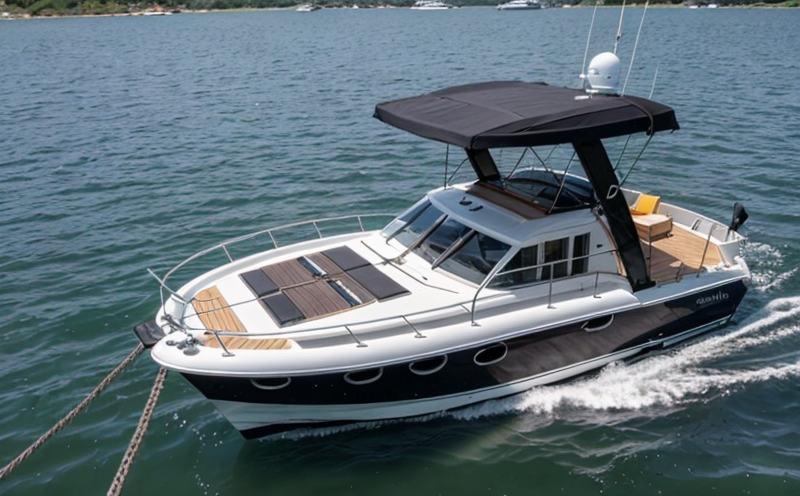IEC 60204 Electrical Safety Testing of Mooring Winches
The IEC (International Electrotechnical Commission) standard 60204-1:2013, titled “Safety of machinery – Electrical equipment and protective devices for use in machinery,” sets forth the essential requirements and tests that ensure the safety of electrical components used in marine machinery. One such application is the testing of mooring winches, which are critical to maritime operations involving securing ships at a pier or anchoring them in open waters.
Mooring winches play an indispensable role in the safe operation of vessels by ensuring secure attachment and release from various anchor points. These machines must function reliably under harsh marine environments where electrical components may be exposed to moisture, salt spray, and extreme temperatures. The IEC 60204 standard provides a framework for testing these devices to guarantee their compliance with safety requirements.
The testing process involves several key steps that ensure the winch’s adherence to international standards:
- Initial Inspection: The first step is an inspection of the winch’s electrical components and connections. This includes checking for proper insulation, grounding, and terminal markings.
- Insulation Resistance Testing: Measuring the resistance between different parts of the circuit to ensure there are no unwanted conductive paths that could lead to short circuits or electric shocks.
- Earth Leakage Current Measurement: Determining how much current flows through the protective earth (ground) connection to identify potential hazards and assess whether it meets safety limits.
- Overload Protection Verification: Ensuring that overcurrent protection devices are correctly set up to trip in case of excessive load conditions, protecting both personnel and equipment from damage.
The testing procedure is meticulously detailed within the IEC 60204 standard. Compliance with these stringent requirements helps prevent accidents and ensures a safer working environment for all involved parties. By adhering to this international standard, manufacturers can demonstrate their commitment to quality and safety while meeting regulatory obligations.
Furthermore, regular testing of mooring winches according to IEC 60204 standards is crucial for maintaining the reliability and longevity of these devices. Regular inspections help identify any signs of wear or damage early on, allowing for timely repairs before they become critical issues. This proactive approach not only enhances operational safety but also reduces maintenance costs by preventing costly breakdowns during critical operations.
In summary, IEC 60204 electrical safety testing is vital in ensuring the reliability and safety of mooring winches used in marine environments. By following this stringent standard, manufacturers can guarantee that their products meet global safety requirements while also enhancing overall operational efficiency and reducing risks associated with electrical hazards.
Why Choose IEC 60204 Electrical Safety Testing?
The benefits of adhering to the IEC 60204 standard extend beyond mere compliance; they encompass a range of advantages that contribute significantly to the success and safety of maritime operations:
- Enhanced Reliability: Regular testing ensures that mooring winches operate flawlessly, minimizing the risk of failures during critical moments.
- Improved Safety: By identifying potential electrical hazards early on through rigorous testing protocols, operators can take preventive measures to safeguard crew members and equipment.
- Regulatory Compliance: Demonstrating adherence to international standards helps businesses meet regulatory requirements, avoiding costly penalties and ensuring smooth operations.
- Increased Efficiency: Reliable winches mean less downtime for maintenance, allowing vessels to remain operational longer and more efficiently.
- Better Reputation: Consistent quality control practices reflect positively on a company’s reputation, building trust among clients and stakeholders.
Benefits
The benefits of undergoing IEC 60204 electrical safety testing for mooring winches are multifaceted, extending to both operational efficiency and safety. Here’s a detailed look at these advantages:
- Operational Reliability: Ensures that the equipment performs consistently under various environmental conditions.
- Safety Enhancement: Identifies potential risks early, reducing the likelihood of accidents and injuries.
- Compliance Assurance: Demonstrates adherence to international standards, facilitating smoother operations and avoiding penalties.
- Economic Savings: By preventing costly repairs and replacements due to failure, it reduces long-term expenses.
- Customer Satisfaction: Meeting stringent safety requirements builds trust among clients and enhances brand reputation.
In conclusion, investing in IEC 60204 electrical safety testing offers substantial benefits that far outweigh the initial costs. It is an essential step towards ensuring the highest level of safety and reliability in maritime operations.
Industry Applications
- Vessel Maintenance: Regular testing ensures that mooring winches are safe for use during routine maintenance activities.
- Crew Safety: Identifies potential electrical hazards, safeguarding crew members’ lives in potentially dangerous situations.
- Mechanical Integrity: Helps maintain the structural integrity of vessels by ensuring that critical components like mooring winches function correctly.
- Environmental Protection: By reducing the risk of electrical fires or leaks, it contributes to a cleaner and safer environment for all stakeholders involved.
Use Cases and Application Examples
The use cases for IEC 60204 electrical safety testing of mooring winches are diverse, reflecting the broad range of applications within the maritime industry. Here are some specific scenarios where such testing is crucial:
- Port Operations: Ensuring that mooring winches operate safely during docking and undocking procedures.
- Ancillary Services: Providing reliable support services for vessels in port, ensuring smooth transitions between berths.
- Offshore Drilling Platforms: Maintaining the integrity of mooring systems on platforms far from shore, where electrical safety is paramount.
- Ferry Services: Guaranteeing safe and efficient boarding and disembarking processes for passengers and cargo.





